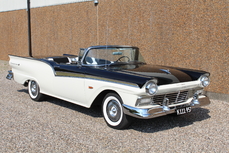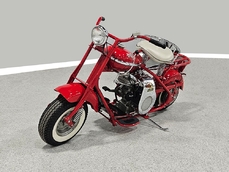Ford Fairlane 482 cubic inch V8 1960
General description :
You may be surprised to learn this, but this incredibly well-built 1960 Ford Fairlane is one of the very best cars we’ve ever featured. Easily in the top 10 and maybe even top 5. And it is entirely because of the quality and uniqueness of the build. It was restored by a gentleman who purchased and raced the very first 1960 Ford Fairlane with the 352 cubic inch V8 and 360 horsepower, and wanted to re-create that car once again. Isn’t that what drives the entire hobby? Fortunately, with the advances in technology and tuning, what he ended up with is a car that looks and feels like a new 1960 Ford but which has vastly more performance than anyone could have imagined in 1960. How does 550 horsepower sound to you? Docile but ferociously fast, comfortable, and a lot of fun to drive, this Ford gets everything right and wraps it in a package you may not have considered before but probably should now. This really is a great car.
Starting with a laser-straight California body is a big part of why this car feels so right. You’ll glance at the door tag (the original one, by the way) and see that this car came from the factory with an X-code 352 with 220 horsepower, so all the V8 hardware was already in place. It’s also a Wimbledon White car from new, so the restoration took it back to stock configuration. Wimbledon White was Ford’s go-to color for competition and it looks fantastic on the all-new 1960 sheetmetal. Low, wide tailfins, a sleek greenhouse with a sloping rear window, and four headlights up front make the 1960 Fords some of the most attractive cars of the era. That super clean west-coast sheetmetal received a show-quality respray in that original Wimbledon White, but only after they spent a lot of time blocking it and getting the gaps lined up just right—those giant quarters don’t have a ripple or wave anywhere on them. Open and close the doors and you’re rewarded with a solid THUNK but no rattles or looseness, and the two-door sedan body is probably the most rigid of the bunch. My point is, cars like this don’t usually get restored to this level and it’s obvious where a good chunk of the $85,000 restoration budget was spent.
The bottom-of-the-line Fairlane didn’t get a lot of trim, but in 1960, that’s like saying Brad Pitt doesn’t meet as many girls as he did when he was 25—there’s still plenty. Even the base, stripped-down cars like this got the wonderfully ornate grille and strips of chrome that run from nose to tail, as well as the neat little bombsight fender ornaments. Big FORD block letters on the nose and tail spell out exactly what just blew your doors off and the bumpers could double as battering rams. The half-moon taillights’ shape is echoed in the bumper, which is a neat effect, and the stainless around the windows has been polished to a high shine. Those are decals on the quarter windows, replicating the look of the original race car as it competed in the C/Gasser class back in 1961, but you can remove them if you don’t like the look. And please take a moment to examine the rear window and the way it meets the deck, a neat detail that often gets overlooked. Even without the big firepower, this is a great-looking car.
Seeing as this car was built for combat, the interior is bare-bones, just as you’d expect. But that doesn’t mean it’s uncomfortable. Quite the contrary, in fact, thanks to new upholstery with fresh foam underneath, so the seats are firm and supportive. The cloth and vinyl upholstery is correct, the carpets are new, and we suspect the door panels might be original, but they’re awfully nice. The original wheel and dashboard were painted silver-gray, just as they would have been originally, and the control knobs are all in excellent shape. A vintage tachometer is strapped to the steering column and there’s a trio of period-perfect Stewart Warner gauges under the dash, all just as they would have been when this car was doing its thing in 1960. The original speedometer and fuel gauge are operational, but the temperature gauge has been superseded by the aftermarket unit. There is no radio, and by the looks of the block-off plate, maybe there never was. The Hurst shifter with a cue ball knob looks industrial sticking out of the transmission tunnel like that, and it falls easily to hand so you never have to think about missing a shift. Also of note, there are power windows hidden inside the doors, with switches that are disguised as the original cranks—use care because it just takes a fingertip, not a hard crank. There’s almost zero wear anywhere inside and the back seat has probably never hosted a passenger. Seat belts were added for safety (that’s just smart in a car that goes this fast). The trunk is massive and includes a correct plait mat set, a proper spare tire, and a jack assembly, so don’t simply assume this is a stripped-down race car—it’s a street car with a mission.
And that mission is kicking serious butt. The decals on the chrome valve covers say “352” because that was the biggest engine available in 1960, an engine with a Holley 4-barrel and 360 horsepower (beating Chevy’s 348 Tri-Power with its 335 horsepower). But you can ignore that today, because it’s been bored and stroked to 482 cubes and a thundering 550 horsepower. Of course, the first thing you notice under the hood is the incredible Edelbrock intake system that uses six two-barrel carburetors and a set of velocity stacks to really make it sing. There’s also a vintage magneto that’s been converted to electronic ignition, so this engine has a period performance look with modern reliability working behind the scenes. That exotic intake system is remarkably docile, starting easily with just a pump or two on the throttle, and it idles nicely warm or cold. Throttle response is smooth and progressive and you don’t get the impression that it’s over-carbureted at all, because it’s just as happy trundling along in town at 30 MPH as it is hammering at full throttle through the quarter mile. The tuning is really very impressive. There’s also a giant aluminum radiator up front that keeps the big FE powerplant cool in traffic and the detailing is just how it would have been in 1960. There’s a modern dual reservoir master cylinder, which was needed for the front disc brakes, but I don’t think anyone will complain about the added safety. New wiring, a custom fan shroud, and quality workmanship throughout illustrate again why this is such a special car.
The stout V8 is backed by a Toploader 4-speed manual transmission and a rebuilt 9-inch rear end with 3.55 gears inside, so it’s more than comfortable on the street yet still has plenty of punch. This was a frame-off restoration and the undercarriage shows lots of clean satin black sheetmetal but no signs of rust or previous damage. The front suspension was fully rebuilt, there are new lines and hoses throughout, and even the driveshaft appears to be a freshly-built piece with fresh U-joints. The dual exhaust system uses ceramic-coated long-tube headers and a pair of electric cut-outs to give this Ford something of a split personality; with the pipes closed, it’s muscular but never annoying. Open them up, however, and the monster is unleashed, cackling and snarling like a full-race piece. Fresh shocks help with the surprisingly comfortable ride and this sucker tracks like a cruise missile on the street with no wandering or looseness from the steering. It just drives beautifully. The rolling stock is race-ready, with sand cast Torque Thrusts up front and steel wheels in back (note the extra-long wheel studs for safety), and the tires are proper 7.60-15 blackwalls in front and sticky 28x11.50-15 Mickey Thompsons in back.
It isn’t an exaggeration when we say this is one of the best cars that we’ve ever featured. It’s smooth, comfortable, fully sorted, quite handsome, and yes, insanely fast. If you like vintage race cars, this one is a slam-dunk, and even if you just want a cool, unusual old car with a ton of horsepower, you’ll scarcely find better. We are very impressed with this car and we’re sure you will be, too. Call today!
http://www.harwoodmotors.com/vehicles/inventory_details.php?id=761
1960 Ford Fairlane 482 cubic inch V8 is listed sold on ClassicDigest in Macedonia by for $39900.
Car Facts
Car type : Car Make : Ford Model : Fairlane Model Version : 482 cubic inch V8 Engine size : 0.0 Model Year : 1960 Location : Ohio
Sold
Seller Information
Sold
People who viewed this Ford Fairlane also viewed similar Ford listed at ClassicDigest
Other cars listed for sale by this dealer
About Ford
Ford, founded in 1902, has arguably changed the history of automotive world more than any other car manufacturer by introducing the first people's car Model T in 1908. They had produced more than 15 million cars by the end of the production in 1927, by which T had become obsolete.Ford launched the first low priced V8 engine powered car in 1932. 1932 V8 was an instant hit with superior handling and performance to many far more expansive cars of the day. No wonder 32 V8 Ford has become such a favourite among hot rodders around the world with 32 Deuce coupe as their icon.
During the war Ford completely shut down civilian vehicle production to dedicate all its resources to the Allied war efforts (1942-45) They used to build B-24 bombers, aircraft engines, jeeps, M-4 tanks, military trucks and Bren-gun carriers and more than 30,000 super-charged Rolls Royce Merlin V-12 engines for Mosquito and Lancaster bombers as well as P-51 Mustang fighters. After the war Ford cars in the USA got bigger and flashier along with their competitors. In the 60's Ford was back in the forefront again when introducing their commercial hit Mustang in 1964. Mustang was so popular the competition had to follow Ford's example and the ponycar phenomenon took over the US. Over the years the ponies grew some muscles until the oil crisis kill finally killed them off.
In the sixties Ford rushed into international motor sports scene with a fury. After unsuccessful Ferrari takeover, when Enzo Ferrari had cut the deal off with Henry Ford II making the latter absolutely boil with fury, Ford turned to Lola in UK to produce a Ferrari beating long distance racer after. The collaboration between Ford and Lola created the mighty Ford GT40 that absolutely beat Ferrari in Le Mans 24 numerous times.
In Europe, Ford introduced some of the most epic race and rally cars of the 60's based on humble family sedans; Cortina GT, Lotus Cortina, Escort Twin Cam, and Escort 1600RS with the iconic Cosworth BDA engines.
Today classic Fords are extremely popular with enthusiasts and a great selection of classic Fords can be found for sale at www.ClassicDigest.com











